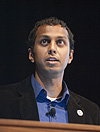Bodhitha Jayatilaka wins 2012 URA Tollestrup Award
 |
Bodhitha Jayatilaka
Photo: Reidar Hahn |
Over five years ago, when Bodhitha Jayatilaka decided he wanted to make a better measurement of the W boson mass, several of his peers equated this desire with something approaching lunacy. But he understood the task differently, as a chance to solve an important problem from start to finish.
It was meticulous work, but Jayatilaka’s dedication earned him this year’s URA Alvin Tollestrup Outstanding Postdoctoral Research Award for leading the effort to produce the most precise measurement ever made of the W boson’s mass.
The Tollestrup Award is given annually for outstanding work conducted by a postdoctoral researcher at Fermilab or in collaboration with Fermilab scientists.
The honor came as a surprise to Jayatilaka, a postdoc at Duke University.
“I know several of the other candidates, and I think very highly of them and their work,” he said.
Narrowing the possible mass range of the heavy W boson helps scientists close in on the last big missing piece of the Standard Model, the Higgs boson. Though much has been made of the attempts to track down that particle, pegging the size of the W has its own trials. As the prize’s namesake Alvin Tollestrup said at the June 13 award presentation, “It’s an incredibly messy measurement to make.”
Most of the mess is the particular aftermath of a collision that results in a W decay. To measure the W precisely, one has to measure each member of its decay cascade precisely. That requires a detailed understanding of the detector’s response to the decays and of physics beyond W production in the Tevatron environment.
Data was read through the hundreds of thousands of channels in the Tevatron’s CDF detector, where Jayatilaka made the W measurement.
“Achieving this kind of precision requires accounting for effects and looking at detail that pretty much no other analysis at CDF, or any other collider experiment, does,” Jayatilaka said.
“The committee had an extraordinarily competitive set of submissions,” said Northeastern University’s Emanuela Barberis, chair of the Tollestrup Award committee. “Dr. Jayatilaka’s work on the measurement of the W mass was impressive in many ways, requiring an unmatched understanding of the detector and the underlying physics.”
In 2009, scientists had measured the W mass to within 0.04 percent by combining results from experiments including those at CERN's former Large Electron-Positron collider and at the Tevatron. Jayatilaka’s recent work at CDF helped shrink that uncertainty to 0.02 percent, showing the mass to be 80,387 ± 19 MeV. It also helped significantly boost the Tevatron's share in the new world average.
“It’s five years of work condensed into two numbers,” he said.
“This is a cornerstone measurement for the Tevatron,” Barberis said. “It takes years of dedicated work and strong leadership to pull together a result such as this, and Dr. Jayatilaka succeeded at it.”
—Leah Hesla |